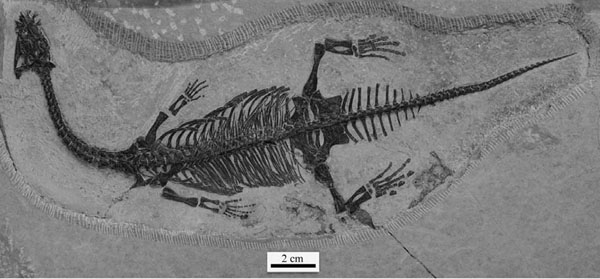The marine Triassic deposits in southwestern China have yielded numerous vertebrate fossils (ichthyosaurians, sauropterygians, thalattosaurians, and fishes). A new eosauropterygian, Diandongosaurus acutidentatus gen. et sp. nov., a complete skeleton with the skull articulated, was found from the Upper Member of Guanling Formation (middle Anisian, Middle Triassic) of Luoping County, Yunnan Province, southwestern China, as reported in the journal of Vertebrata PalAsiatic 2011(2) by Drs. SHANG Qing-Hua, LI Chun, Institute of Vertebrate Paleontology and Paleoanthropology, Chinese Academy of Sciences, and WU Xiao-Chun, Canadian Museum of Nature Ottawa.
In this new eosauropterygian, the frontals and the parietals are fused, the posterolateral process of the frontal extends posteriorly over the anterior margin of the supratemporal fenestra, the postorbital is excluded from the infratemporal fenestra by the jugal-squamosal contact, the quadratojugal is present, the clavicle has an anterolateral projection, and the three sacral and anterior caudal ribs are distally pinched off but not constricted. Unlike in most of other primitive eosauropterygians, the prefrontal and the postfrontal meets each other along the dorsal margin of the orbit, the descending ramus of the squamosal reaches the articular condyle of the quadrate, caudal ribs 3 to 8 are elongate and longer than sacral ribs, and the ungual phalanxes of the pes are extremely dorsoventrally expanded.
Diandongosaurus acutidentatus is also a morphological mixture, displaying a combination of nothosaurian and pachypleurosaur features. This new species shared many similarities with the pachypleurosaurs, such as the preorbital region of the skull longer than the postorbital region, the supratemporal fenestra distinctly smaller than the orbit, the distinct trough/fossa on the dorsal surface of the retroarticular process. On the other hand, Diandongosaurus acutidentatus is comparable to the Nothosauroidea in some other characters, such as the anterior premaxillary and dentary teeth strongly procumbent, the presence of one or two maxillary caniniform teeth, the fused frontals and parietals, the parietal skull table weakly constricted, and the absent of the zygapophyseal pachyostosis. However, Diandongosaurus acutidentatus is also distinguishable from the pachypleurosaurs and the nothosaurs in some other features as recognized by the present analysis.
“Although this new eosauropterygian is known from a single skeleton, the excellent nature of its preservation provides a solid basis for its taxonomic identification and phylogenetic relationships”, said Dr. SHANG Qing-Hua, lead author, “Our phylogenetic analysis suggests that Diandongosaurus is neither a pachypleurosaur nor a nothosauroid; it might be the sister group of the clade consisting of Wumengosaurus, the nothosauroids and those taxa traditionally considered as pachypleurosaurs.”
This work was supported by the National Natural Science Foundation of China, the Major Basic Research Projects of the Ministry of Science and Technology of China, the Canadian Museum of Nature, and the CAS/SAFEA International Partnership Program for Creative Research Teams.  Fig.1 Skeleton of Diandongosaurus acutidentatus gen. et sp. nov. (holotype, IVPP V 17761) (Photo by Shang Qing-Hua) |
